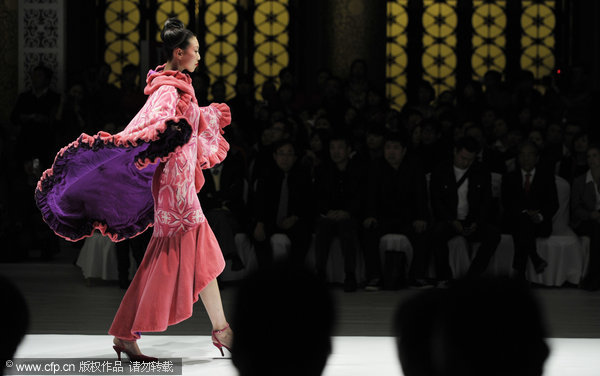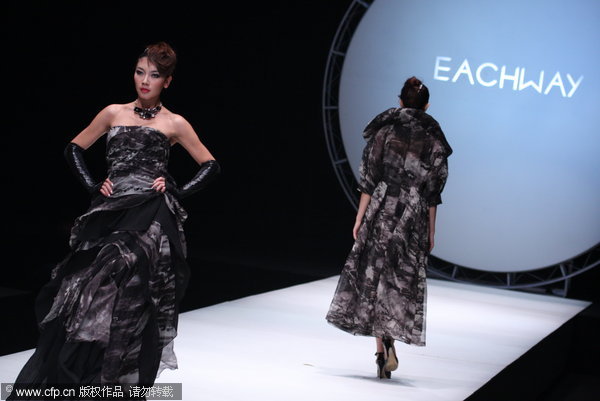It's all in the details
|
 |
|
Ne Tiger's new collection [CFP] |
More than 40 fashion shows by 50 brands and 220 designers went to China Fashion Week Spring Summer 2010 at D Park, Beijing House and Beijing Hotel, and all the talk was about Chinese elements.
The week's opening event, Aimer National College Invitation Contest for Women's Wear Design, saw first prize winner Liu Zhen rewarded for her Chinese-element designs.
Though four of his works were short Western evening dresses, the black hats with feathers and silk belts, were inspired by old-Shanghai flourishes.
Ne Tiger, the second show of the week, featured luxurious cheongsam-like costumes that emphasized embroidery.
There were butterfly, flower and paper fan patterns, and clouds, with dark blue, gold, red, black and white as the basic colors.
"We should dig deep into our traditions and culture, which is needed more than ever today," says Zhang Zhifeng, art director and designer of the brand.
"We see fans as gentlemen, and butterflies as women. This comes from an ancient Chinese concept. You might see some Western evening dresses, but all the symbols are Chinese.
 |
|
Eachway's show [CFP] |
Zhao Huizhou, designer of Shenzhen-based brand Eachway, agrees with him. Besides adding a live performance of the guqin (a seven-stringed plucked instrument) to her show, Zhao used "fish" as a symbol of Chinese women.
Gray, black and white were the only colors, while black lace peonies and roses were attached to the skirts. Silk belts, open shoulders and layers of gauze handkerchiefs emphasized elegance.
Throb-Immobile's show presented the image of powerful office ladies and had accessories like metal-like underwear and handbags. Model Qi Qi led the show with a one-piece dress made of hundreds of iron pieces. Inspired by a warrior's armor, the dress was "extremely heavy," Qi admits.
DGVI's collection had a young, funky, Bohemian style, with its scarves, animal patterns and vintage sunglasses, plus summer sun-tops with Chinese ink-and-wash paintings.
Last but not least, there were more than 10 brands and designers from Taiwan.
These designers chose elements of Chinese culture and in Tsai Meiyue's wedding dress show there was gold and red, traditionally imperial colors. Tsai even embroidered a traditional Western wedding dress.
"Oriental beauty is different from the rest of the world. We have a different body shape and different habits. I never wanted to follow Western fashion patterns, I created my own," Tsai says.
Yang Jian, secretary general of the China Fashion Week Committee, says there are many foreign designers using Chinese elements.
"However, using Chinese elements in fashion is not a simple copy-and-paste. It should match the age we are living in," Yang says.
"Chinese elements might not be the mainstream in the world's fashion industry but for Chinese designers, they have to look back to be more international," adds Xia Shang, fashion reporter from China Textile Newspaper.
 0
0 







Comments